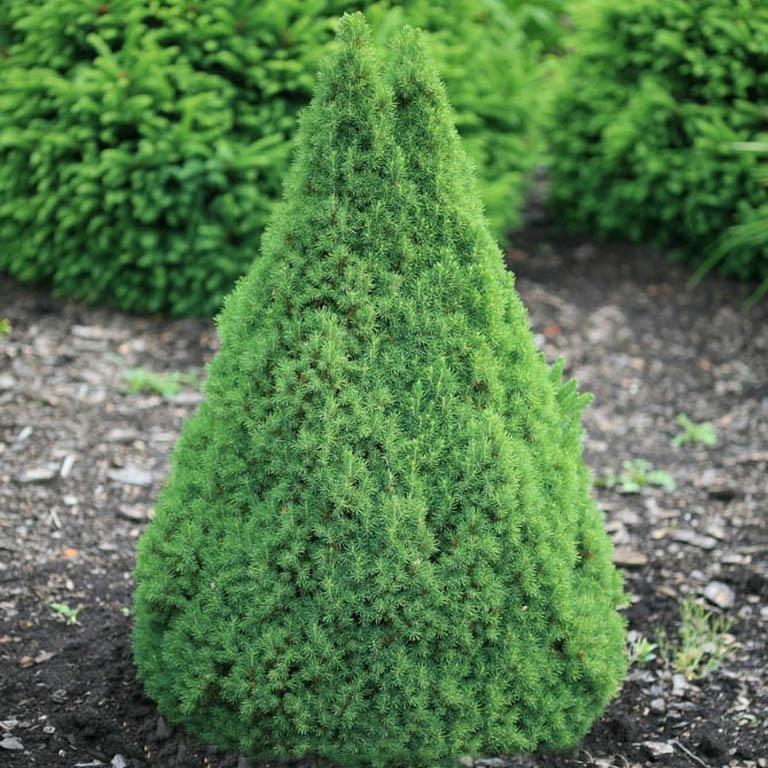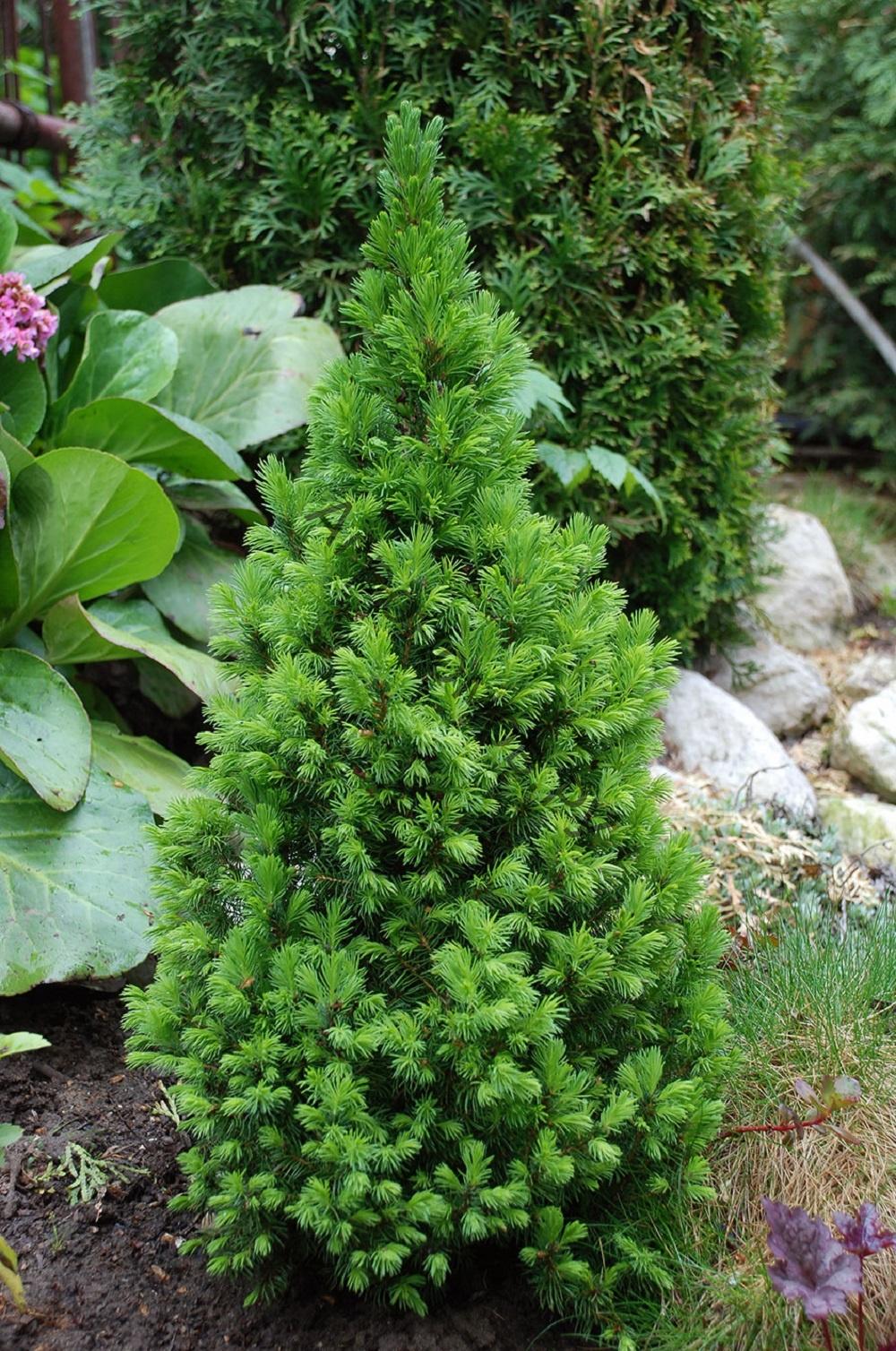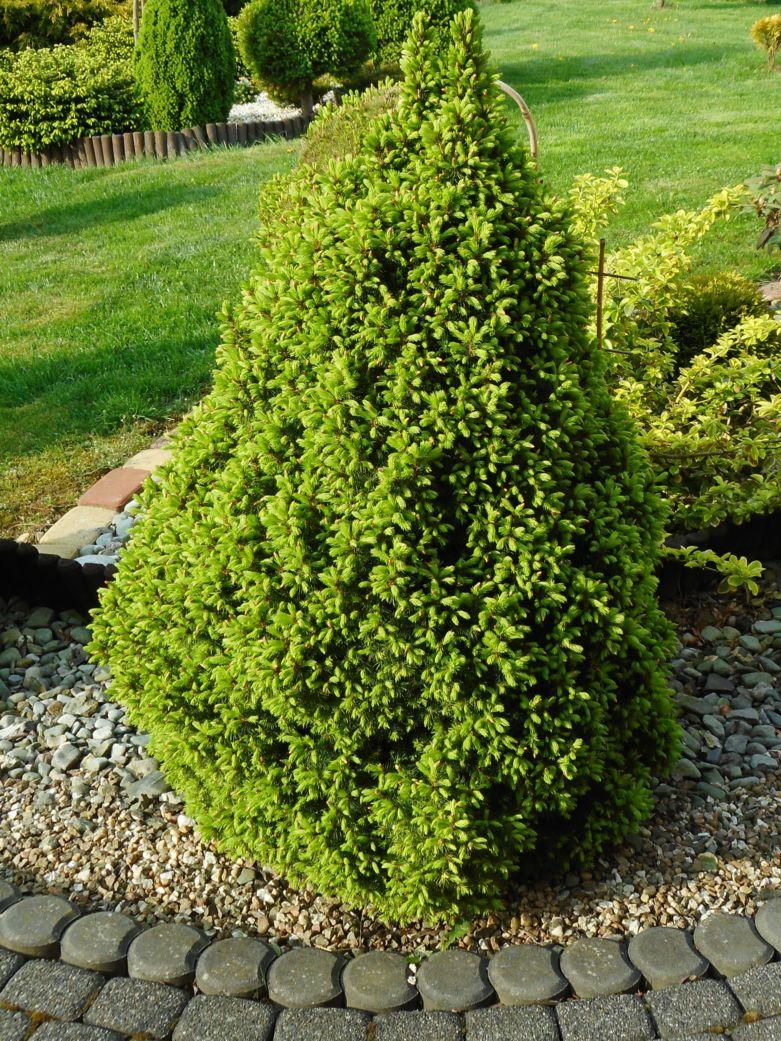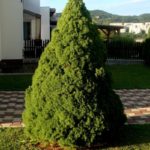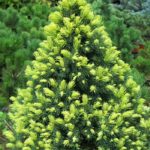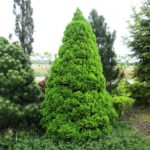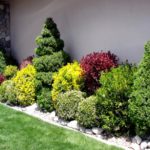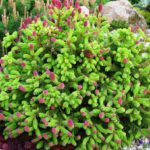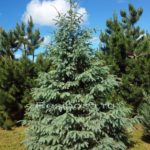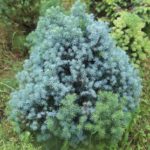Konica is an ornamental plant that is small in size. When grown at home, its height does not exceed 30 centimeters, and in the garden the tree reaches 2 meters. Konica was bred at the beginning of the last century in North America. There this plant reaches a height of 3-4 meters. Despite the unpretentiousness of the Koniki spruce, proper care is still required when growing it. This will help avoid the development of diseases and pest attacks.
Description
Canadian spruce Konica is also often called white, gray or Glauka. It is a derivative of the dwarf form of the beautiful Canadian blue spruce. Decorative culture is characterized by the following features:
- Size and age. An adult Konika spruce reaches a height of 3-4 meters. The diameter of the crown is 2 meters.
- Annual growth. In good conditions, spruce grows a maximum of 6-10 centimeters during the year. Slow development is considered a key advantage of coniferous plants.
- Crown shape. Spruce has an ideal cone shape and requires virtually no correction. Moreover, the crown is so dense that it completely hides the trunk. This feature makes spruce very attractive from the point of view of use in landscape design.
- Needles and flowers. The tree is characterized by medium-hard needles that have a dark green tint. The length of the needles is no more than 9-10 millimeters. The tree looks most attractive in May - during bud break. Young needles have a soft structure and a light green tint. By the end of summer, the needles become stiffer and acquire a dark color.
Konica bears fruit extremely rarely. When this occurs, small bright brown cones densely cover the branches from the center of the tree to the top. At the same time, they represent an additional decoration. The lifespan of the plant is 30-50 years.
Popular varieties
Glauka Konica has a number of varieties. The most common varieties include:
- Alberta Globe. This culture was discovered in the Netherlands in 1967. It is a dwarf plant that has a spherical crown. By the age of 10, the crop has a diameter of no more than 30 centimeters.In adult crops, the crown reaches a height of 90 centimeters and a width of 120. It has a green color.
- Blue Wonder. This plant was discovered in Germany in 1984. This crop is distinguished from the original variety by its more compact size. At 10 years old, the height of the tree does not exceed 70 centimeters. Older trees can grow up to 2 meters. In this case, the crown in diameter is 75 centimeters. However, the main feature is the color of the needles. It is characterized by a bluish tint.
- Daisy White. This variety was obtained in Belgium in 1979. It is characterized by a pyramidal crown. By the age of 10, the tree grows a maximum of 80 centimeters. The key advantage of spruce is the color of young shoots. At first they are yellow, then turn white, and after that they take on a green color.
- Dwarf. This plant grows very slowly. The annual growth does not exceed 3-5 centimeters. At the same time, the needles are characterized by a gray-green color.
- Laurin. This variety was developed in Germany in 1950. The plant is a dwarf variety characterized by very slow growth. In 1 year, the tree grows literally 1.5-2.5 centimeters. It is characterized by an outstretched crown and green needles.
Spreading
In its natural habitat, the plant is found in forested areas of Canada. That's where it was discovered. This happened in 1904 on the coast of Lake Lagan. Quite a few Konik spruce trees are grown in nurseries. This plant is often used to decorate areas and decorate the interior of residential premises.
Landing Features
In order for the plant to grow normally and maintain its decorative properties, it is important to carry out planting work correctly.
Best time to plant
Choosing the time to plant a plant in open ground depends on the climatic conditions of the region. In central Russia, this should be done from late April to early May. Over the summer, the tree will have time to take root and grow stronger.
Planting work can also be carried out in the fall. This should be done in early September so that the crop has time to take root before frost. Rainy autumn has a particularly favorable effect on this process. In this case, the root system accumulates a lot of moisture.
How to choose a place
You should not plant Konica spruce in an open area. The plant requires protection from sunlight and strong winds. Otherwise, the tree will get burned. Thus, it is recommended to plant the crop in partial shade.
When choosing a site, the level of groundwater is of no small importance. They should be located deep enough. However, it is important to consider that Konica requires moist, well-drained soil. Loamy soil would be ideal.
Selection of seedlings
The gray Canadian spruce Konika is mainly sold in containers. When purchasing such a plant, you need to pay attention to the flowerpot. For high-quality planting material, the diameter of the pot should match the circumference of the crown. This is due to the powerful root system, which takes up a lot of space. A small pot restricts the roots. As a result, the absorbing fragments die off, which complicates the rooting process.
Also, when buying a seedling, you need to pay attention to the appearance of the needles. It should have a juicy shade and not contain damaged fragments.
How to plant correctly
To facilitate the plant’s adaptation to a new location, it is important to carry out planting work correctly. In this case, you need to do the following:
- Dig a hole for planting measuring 50-70 centimeters. Place a drainage layer of 15-20 centimeters in size at the bottom. It may consist of sand, expanded clay or crushed stone. You also need to prepare the substrate. To do this, you need to mix leaf soil, turf, sand and peat in a ratio of 2:2:1:1.
- When planting several trees, maintain an interval of 2-3 meters.
- Pour some of the prepared soil onto the bottom, and place a seedling on top. The root system of the crop needs to be carefully straightened and the spruce is sprinkled with the remaining soil. In this case, the root collar should be located at ground level.
- Cover the tree trunk circle with a mulch layer. To do this, use peat, tree bark, and wood chips. This helps retain moisture.
- Immediately after planting, water the plant. For a seedling it is worth using 10-12 liters, for a more mature plant - 40-50.
If a plant with a closed root system was used for planting, additional fertilizing during planting may not be applied. In other cases, it is worth using a solution to strengthen the root system.
Care requirements
In order for the plant to grow and develop normally, it needs to be properly cared for. It is important to follow a number of rules:
- Water the crop in a timely manner. Konika is characterized by a shallow root system, so in hot weather the spruce needs frequent and abundant watering. It is necessary to moisten the soil once a week. In this case, a young plant needs 10 liters of moisture. Spraying the crown is of no small importance. After watering, the soil must be carefully loosened.This is done to a depth of a maximum of 5-6 centimeters. In autumn, moisture-recharging irrigation is required.
- Feed the plant. It is recommended to do this 2 times during the season, using combined preparations for coniferous plants. Typically, the soil needs to be fertilized in spring and autumn. At the stage of preparation for winter, it is worth using potassium-phosphorus substances. In spring, it is recommended to spray the crown with Epin or Zircon. This is especially true when signs of burns appear.
- Trim the plant in time. The culture does not require crown formation. However, sanitary pruning is required periodically. In this case, you need to remove dry and diseased branches. It is best to carry out the procedure from late spring to early summer. If it is necessary to correct the shape of the plant, it is necessary to pinch the shoots. This will help them become denser and branchier.
- Prepare the plant for winter. The main purpose of this procedure is not to insulate the plant, but to protect it from sunburn. To do this, you need to install a frame around the tree and cover it with non-woven fabric.
Reproduction
When growing a plant outdoors, propagation must be done by cuttings. However, this is a rather complicated process. It is recommended to take cuttings for rooting in early spring. This should be done from the end of March to the beginning of April. It is necessary to tear off shoots with a heel - a fragment of the trunk bark. It is best to prepare planting material in cloudy weather. The optimal cutting length is 7-10 centimeters.
The harvested shoots need to be soaked for a day in the root formation stimulator “Heteroauxin”. After which they need to be planted in light fertile soil, placing them at an angle of 30 degrees.The cuttings should be deepened by 2-3 centimeters. They need to be placed in separate pots, then covered with a jar or bag. It is recommended to ventilate the plantings once a day.
Dangers to spruce
When growing a plant at home or in open ground, it may suffer from the development of diseases or pest attacks. The most common pathologies include the following:
- Tracheomycosis is a soil fungus that can lead to damage to the root system of conifers. When the plant is damaged, redness and loss of needles are observed. Treatment of the affected tree will not produce results. To save the remaining crops, the infected spruce must be dug up along with the roots and burned.
- Schutte - the development of the disease is associated with infection with coniferous fungi. When they are damaged, the needles become dark in color. After which a white coating accumulates on them. In this case, Konik needs to be treated with a solution of copper sulfate with a concentration of 3%. Then the culture should be sprinkled with Trichodermin or Alirin-B. If the damage is severe, the tree must be burned.
- Rust is a fungal infection of branches. At the same time, orange growths form on them. Then the needles turn yellow and fall off. To treat pathology, it is worth using Glyokladin.It is recommended to carry out treatment once a week for a month.
Sometimes the plant suffers from pest attacks. Konika is more susceptible to attacks by the following parasites:
- Spruce false scale insect attacks plants in late spring. In this case, the female can lay up to 1.5 thousand larvae. In appearance they resemble small brown balls. Infection of a plant with parasites leads to needles falling off. The BI-58 remedy helps to cope with them.
- Bark beetle - causes damage to the bark. If a tree is infected by these parasites, it will have to be destroyed.
Application in landscape design
Konika spruce has a compact size, which is why it is often used in landscape design. The following options are possible:
- Single landing. In this case, the plant can be planted in the ground or placed in a container in the garden.
- Garden compositions. A neat spruce will perfectly complement a rock garden or rock garden. It pairs well with grains, flowers and hostas.
Konika spruce is a fairly common plant that has excellent decorative properties. In order for a culture to develop normally, it needs to be planted correctly and provided with proper care.

